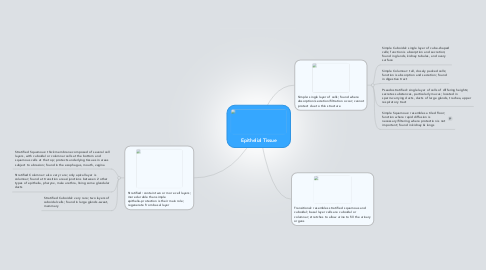Epithelial Tissue
作者:Paige Salwei

1. Stratified: contain two or more cell layers; more durable than simple epithelia-protection is their main role; regenerate from basal layer
1.1. Stratified Squamous: thick membrane composed of several cell layers, with cuboidal or columnar cells at the bottom and squamous cells at the top; protects underlying tissues in areas subject to abrasion; found in the esophagus, mouth, vagina
1.2. Stratified Columnar: also very rare; only apical layer is columnar; found at transition areas/junctions between 2 other types of epithelia, pharynx, male urethra, lining some glandular ducts
1.3. Stratified Cuboidal: very rare; two layers of cuboidal cells; found in large glands-sweat, mammary
2. Simple: single layer of cells; found where absorption/secretion/filtration occur; cannot protect due to thin structure
2.1. Simple Cuboidal: single layer of cube-shaped cells; function is absorption and secretion; found in glands, kidney tubules, and ovary surface
2.2. Simple Columnar: tall, closely packed cells; function is absorption and secretion; found in digestive tract
2.3. Pseudostratified: single layer of cells of differing heights; secretes substances, particularly mucus; located in sperm-carrying ducts, ducts of large glands, trachea, upper respiratory tract
2.4. Simple Squamous: resembles a tiled floor; function where rapid diffusion is necessary/filtering where protection is not important; found in kidney & lungs
3. Transitional: resembles stratified squamous and cuboidal; basal layer cells are cuboidal or columnar; stretches to allow urine to fill the urinary organs


